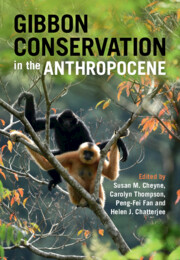Book contents
- Gibbon Conservation in the Anthropocene
- Gibbon Conservation in the Anthropocene
- Copyright page
- Contents
- Contributors
- Foreword
- Abbreviations
- Introduction
- 1 Taxonomy, Ecology and Conservation of Cao Vit Gibbon (Nomascus nasutus) since Its Rediscovery
- 2 Conservation Status of the Northern Yellow-Cheeked Crested Gibbon (Nomascus annamensis) in Vietnam
- 3 Strategies for Recovery of the Hainan Gibbon (Nomascus hainanus)
- 4 Gibbons in the Anthropocene
- 5 Demography of a Stable Gibbon Population in High-Elevation Forest on Java
- 6 A Tale of Two Gibbon Studies in Thailand
- 7 Accessibility as a Factor for Selecting Conservation Actions for Pileated Gibbons (Hylobates pileatus)
- 8 Calling from the Wild
- 9 Demography and Group Dynamics of Western Hoolock Gibbons (Hoolock hoolock) in a Community Conserved Village Population in Upper Assam, India
- 10 Challenges and Prospects in the Conservation of Hoolock Gibbon in India
- 11 Gibbons of Assam
- 12 Movement Ecology of Siamang in a Degraded Dipterocarp Forest
- 13 Sympatric Gibbons in Historically Logged Forest in North Sumatra, Indonesia
- 14 Adopting an Interdisciplinary Biosocial Approach to Determine the Conservation Implications of the Human–Gibbon Interface
- 15 Listen to the People, Hear the Gibbons Sing
- 16 Long-Term Outcomes of Positive Cultural Value for Biodiversity
- 17 Gibbon Phylogenetics and Genomics
- 18 The Use of Microsatellites in the Management of Captive Gibbons
- Index
- References
2 - Conservation Status of the Northern Yellow-Cheeked Crested Gibbon (Nomascus annamensis) in Vietnam
An Update
Published online by Cambridge University Press: 13 April 2023
- Gibbon Conservation in the Anthropocene
- Gibbon Conservation in the Anthropocene
- Copyright page
- Contents
- Contributors
- Foreword
- Abbreviations
- Introduction
- 1 Taxonomy, Ecology and Conservation of Cao Vit Gibbon (Nomascus nasutus) since Its Rediscovery
- 2 Conservation Status of the Northern Yellow-Cheeked Crested Gibbon (Nomascus annamensis) in Vietnam
- 3 Strategies for Recovery of the Hainan Gibbon (Nomascus hainanus)
- 4 Gibbons in the Anthropocene
- 5 Demography of a Stable Gibbon Population in High-Elevation Forest on Java
- 6 A Tale of Two Gibbon Studies in Thailand
- 7 Accessibility as a Factor for Selecting Conservation Actions for Pileated Gibbons (Hylobates pileatus)
- 8 Calling from the Wild
- 9 Demography and Group Dynamics of Western Hoolock Gibbons (Hoolock hoolock) in a Community Conserved Village Population in Upper Assam, India
- 10 Challenges and Prospects in the Conservation of Hoolock Gibbon in India
- 11 Gibbons of Assam
- 12 Movement Ecology of Siamang in a Degraded Dipterocarp Forest
- 13 Sympatric Gibbons in Historically Logged Forest in North Sumatra, Indonesia
- 14 Adopting an Interdisciplinary Biosocial Approach to Determine the Conservation Implications of the Human–Gibbon Interface
- 15 Listen to the People, Hear the Gibbons Sing
- 16 Long-Term Outcomes of Positive Cultural Value for Biodiversity
- 17 Gibbon Phylogenetics and Genomics
- 18 The Use of Microsatellites in the Management of Captive Gibbons
- Index
- References
Summary
We review the results of recent surveys for the northern yellow-cheeked crested gibbon (Nomascus annamensis) on the eastern slope of the Annamite Range in Binh Dinh and Quang Ngai provinces, and update its conservation status in Vietnam. Surveys were conducted in three adjacent forest blocks: West Ba To Proposed Nature Reserve (NR), An Toan NR and Vinh Son Commune, with a total area of 367 km2. We documented gibbon densities of 0.41 and 0.15 groups/km2 in the first two sites but did not find any groups in the third location. We detected 46 groups and estimated 114 groups in these areas, about 14 per cent of Vietnam’s known population of N. annamensis. Our archival study revealed that at least 317 groups of this species have been confirmed in Vietnam. The distribution range is between approximately 14° 00′ and 16° 50′ N latitude with potential overlap with the southern white-cheeked gibbon in the northernmost portion of this range. Important drivers influencing the distribution of the species in Vietnam include temperature seasonality, elevation, precipitation of the driest month, annual precipitation, and precipitation of driest quarter. This species faces extinction in Vietnam due to fragmented habitat, small subpopulation sizes, illegal hunting and forest conversion.
- Type
- Chapter
- Information
- Gibbon Conservation in the Anthropocene , pp. 24 - 39Publisher: Cambridge University PressPrint publication year: 2023



